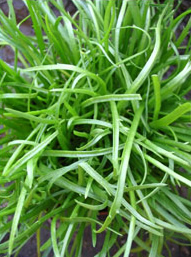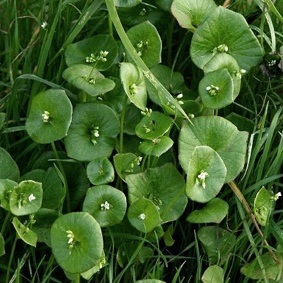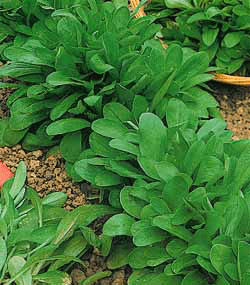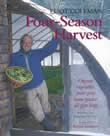Last winter I finally prepped and planted in the greenhouse and was fairly successful in harvesting some salad and braising greens. That time I used a small space heater, fan, and my usual plant varieties. But this winter I will opt to forego the heat and plant hardier varieties, and use some specific methods that allow harvesting throughout the winter, as recommended by Eliot Coleman, master gardener and author. The information below is summarized from The Four Season Harvest (1999) and The Winter Harvest Handbook (2009) both written by Eliot Coleman. I urge you to visit his website and to feast your eyes on the ‘photo gallery’. His gardens and greenhouses are both elegant and beautiful.
http://www.fourseasonfarm.com/index.html
Eliot gives the name of 'cold house' to the high tunnel hoop houses that he mainly uses that are left unheated. However, he uses this term generally for any unheated planting structure, such as a greenhouse, cold frame, or hoop house. He describes crops that have been grown and harvested in cold houses in the winter climes of Europe, and he has duplicated those efforts in his Maine gardens for years now. Eliot also describes in his books about the use of ‘cool houses’ that are heated only slightly to keep temperatures above freezing, but this information is focused only on the ‘cold houses’.
Eliot states the obvious importance of adequate warmth for any particular overwintering crops. For those who fear there may not be adequate daylight hours in winter, Eliot affirms that there are sufficient daylight hours in winter throughout the continental USA. The most eye opening example of this is shown in his description of the lush growth of vegetation in winter in one other area of the world which shares the same latitude as he, and therefore the same day length in winter. The difference in the south of France, as compared to where Eliot lives in Maine, is one such place. The main difference is the chill factor, which is greater in Maine due to lack of the warming Gulf Stream current which the south of France enjoys.
What can be grown then depends in part on the hardiness zone, which relates to chilling, and therefore, how much 'cover' is needed to warm the crop area. In zones 7 and 8 one may only require a low tunnel hoop to protect crops; however, in zones 3 to 6 a more substantial cover to support snow, such as a cold frame, hoop house, or greenhouse would be needed.
In regions 3-6, in order to obtain an even warmer microclimate for certain crops, Eliot recommends creating floating row covers with agricultural fabric inside the structure too. He states a cold house alone will create 1 1/2 zones of added warmth than in an unprotected garden. However, having a row cover within the cold house will give an additional 1 1/2 zones of warmth. Therefore, the row cover inside the hoop or greenhouse structure changes the temperature in hardiness zone 5 to zone 8 temperatures!
Also of great importance in successful winter cropping is that of timing the plantings prior to winter. Eliot states it is essential to plant early enough so that the plants are almost to maturity before the day time becomes less than 10 hours.
So, depending on the crops chosen and the various levels of cover given, harvesting can not only be extended through the winter and hastened in the spring, but it can actually allow harvest during ALL the coldest months of the winter. Here is what Eliot has to say about his experience in Maine in zone 5 at the time of his writing.
In zone 3, only 5 crops can be dependably harvested in cold houses all winter. They are spinach, scallions, Mache (which can even be harvested frozen), claytonia and carrots. Other crops in this zone can benefit from an extended growing season, but will require a 2 month rest during the coldest months before they can produce yields again.
 In the warmer growing regions, say regions 5-8, the above mentioned crops can still be harvested throughout the winter, but additionally one should be able to get full winter pickings from: a hardy Swiss chard variety 'Argentata'; minutina; leek; beet greens; sorrel; and some Asian greens. Additionally, other crops can be harvested at least all or part of the winter months, again, depending on the region and level of cover applied: a hardy arugula variety named 'Sylvetta'; frisee endive; baby leaf salad greens; dandelion greens; Asian greens like mizuna, pak choi, tatsoi, and komatsuna; and other greens for braising like turnip, escarole, and chicory.
In the warmer growing regions, say regions 5-8, the above mentioned crops can still be harvested throughout the winter, but additionally one should be able to get full winter pickings from: a hardy Swiss chard variety 'Argentata'; minutina; leek; beet greens; sorrel; and some Asian greens. Additionally, other crops can be harvested at least all or part of the winter months, again, depending on the region and level of cover applied: a hardy arugula variety named 'Sylvetta'; frisee endive; baby leaf salad greens; dandelion greens; Asian greens like mizuna, pak choi, tatsoi, and komatsuna; and other greens for braising like turnip, escarole, and chicory.
 |
|
 |
Claytonia |
|
Mache |
FYI, I’ve been able to get all of these varieties from a nursery in Maine that has a good selection of organic seeds, offers various packet sizes/prices, and does not carry GMO seeds. Their name is Fedco and you can find them at their website: fedcoseeds.com

